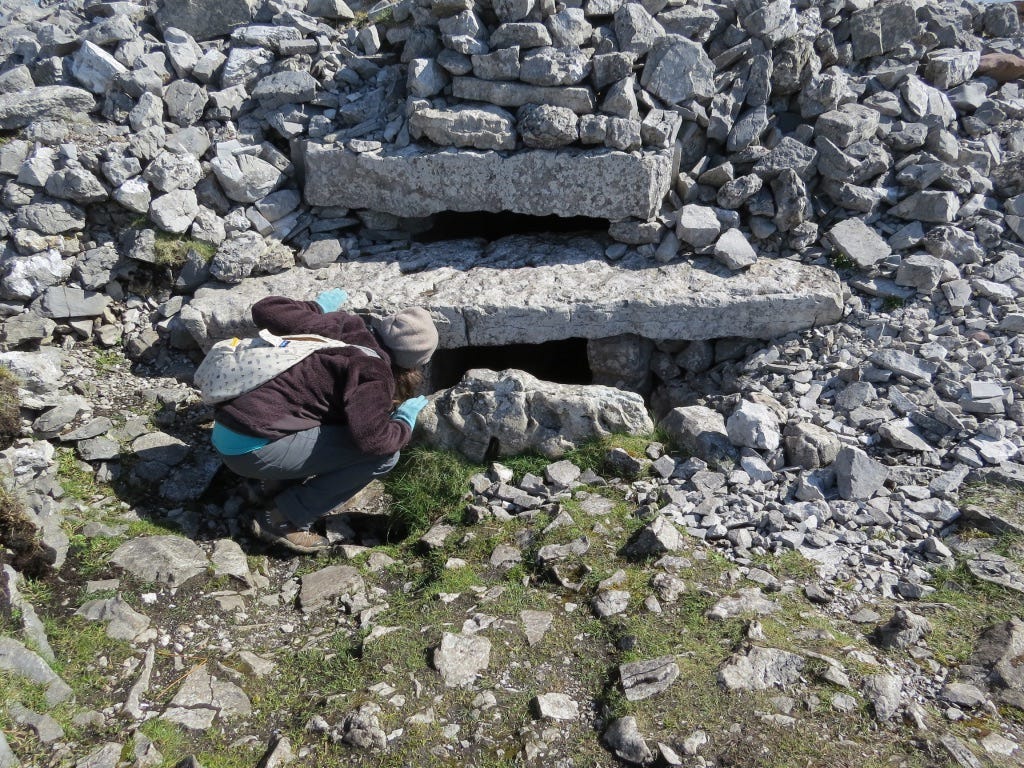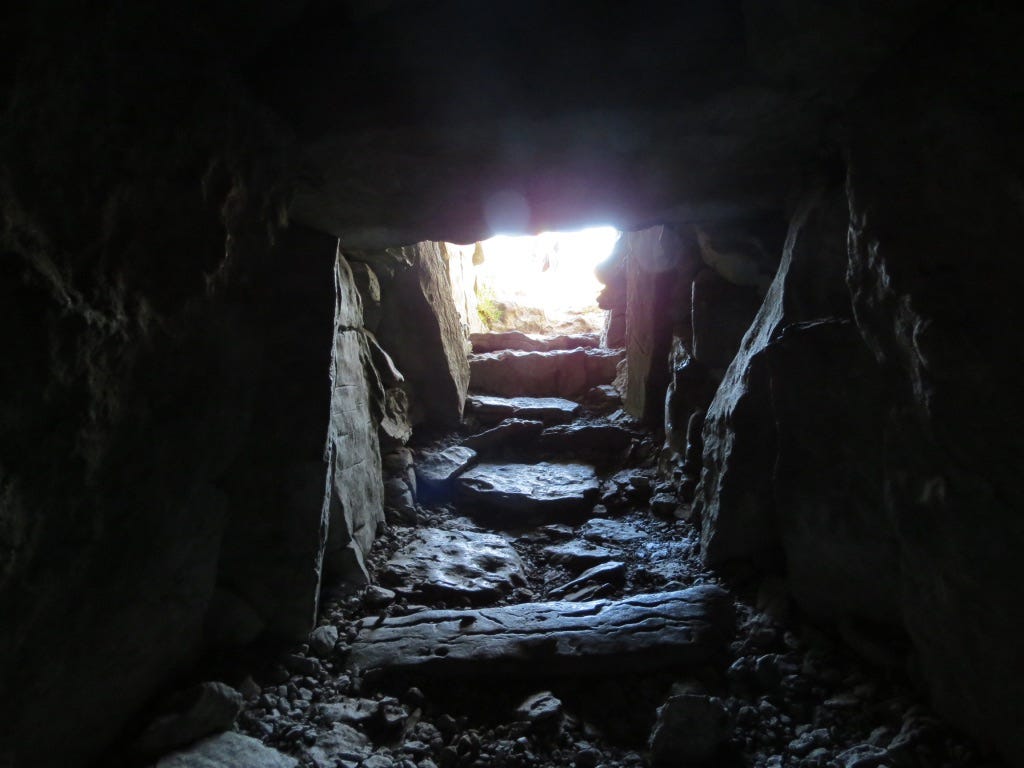2018.
It is my aunt’s birthday, and we are standing inside a cairn built more than five thousand years ago on a muddy hill in Ireland with my mom and my bestie Licia. The four of us, alone with the sheep and the echoes of the past.
The guy at the visitor center at Carrowmore told us we should come up here, that we could crawl into the cairns and catch our breath at the ancient mystery. We drove up on a shrinking-small road, nearly scraping the car against stone walls. Past the donkey sanctuary to where the road became grass and gravel, to a gate closing off the remainder of the road. There, we parked and walked.
Hills shrugged up on one side of the road, sprinkled with sheep and fists of grass. On the other side, the vista opened up. The day was fresh and clear. We could see the blue mound of Knocknarea, which we had climbed that morning, and even the more distant smudges of Benbulben and Slieve League.
We knew the cairns were above us, higher up the hill. One came into view, a thumbprint of pale gray stones rising marginally above the brown blanket bog. A single figure stood beside the mound, but Licia and I could not see where the trail went up. The road curved tight against the hill and we lost sight of cairn and figure.
Just as we were beginning to feel lost, we came around the side of the hill and there was the man we’d seen. He smiled and waved at us. “The trail’s right here!”
We thanked him. Without his help, we would never have recognized the mud-slick hillside functioned as a trail. As we climbed, we joked that the guy had appeared at just the right moment—like a Carrowkeel Jesus.1 And in fact, I am not sure that he had a car back by the lot.
The lip of the hill hid the cairns from sight initially, but Carrowkeel Jesus had not led us astray. As we came up, the first cairn shouldered up over the green, the slits of its roof box and low entrance glowing black against the pale stones.
In the manner of all best friends from the Neolithic to the present, even though I was the one who had dragged us up there, I made Licia go in first. :D
We squeezed past the front stone, then dropped to our knees to crawl through the narrow passage, as tight as a birth canal. Our phone flashlights flickered bluely over the round chamber within. We both unfurled, standing cautiously upright. A corbeled roof stacked up over our heads. Tea candles perched in the niches between the large upright stones that supported the structure.
The air inside tasted cool and ancient. If not for the tea candles and some graffiti scratched on the stones, it would be easy to believe we were the only people who had entered this place in centuries.
My mom and aunt called to us from outside the cairn, and we climbed out so that they could go inside. Licia and I continued up the hillside to where another, larger cairn awaited us. (Yes, I made her go first again.) Again, we had to drop to our knees to enter.
Some pilgrims climb the entirety of Croagh Patrick (visible in the distance from this site) on their knees. I cannot imagine the punishing effect of doing such a thing to my body. Yet here, the act of falling to my knees feels like an act of reverence. These ancient cairns perch on top of hills across the Sligo area, turning the horizon into a tribute to the feminine form, like breasts. But going inside the passage cairn is like entering a womb. We stand up uncertainly in the darkness, breathing in the chill air.
A few minutes later, my mom and aunt arrive, crawling one at a time into the ancient temple. So we are all here, gasping a little in the dark. Distant ancestors put these stones into place, deliberately fit the corbeled roof. The remains of Neolithic huts lie nearby, where those ancestors slept after their long work on the cairns, where they ate, laughed, told stories, dreamed.
I wonder what this place looked like then. The western coast of Ireland would have been warmer, drier, in 3500 BCE. Would trees have covered these hills? Were these cairns placed into a sacred grove, or onto open hillside, or a mix of both?
We can see the evidence of how our ancestors interacted with this ritual landscape. But more than that, we can feel it in our bones, the numinous relation between these intentionally placed stones and this land.
To me, these cairns—these temples, these burial grounds—feel like a reminder that we come from the earth, that it is the land that mothers us, that we are birthed both from a human mother and from a holy mother. That holy mother may have been shrunken and reshaped by centuries of a dominating western culture, but even where her outward appearance has become anodyne, she is still here for us, still holding out her cloak to shelter us all.
Climbing into these cairns is like crawling under her mantle, only, we are moving past a carefully cultivated patriarchal image into an ancient understanding that our ancestors held. Maybe not all of them—I don’t want to imply that our ancient relatives were not human, fallible. But since they are not here, only the wind and the unseen beings and the sheep, what we are left with is the legacy they made with their hands, and it evokes something beyond modern comprehension.
As Dolores Keane sings on Solid Ground:
It's the land, it is our wisdom It's the land, it shines us through It's the land, it feeds our children It's the land, you cannot own the land The land owns you
In the darkness, we smile and pose for photos. My mom and Licia climb into an alcove together and stand there grinning. My aunt puts her hands on her hips and beams at me. “Happy birthday!” I tell her.
We climb back out of the cairn, born back into the blue day.
Resources:
Martin Byrne has a fantastic site dedicated to the megalithic sites of Sligo, and talks extensively about the unique roof box at the first cairn I discussed (Cairn G) which aligns with the moon and other neolithic monuments. (He was the guy working at Carrowmore who told us we could go up and climb into the passage tombs!)
Sacred Ireland by Cary Meehan is my go-to guide for sacred sites around the island.
In case you think I’m kidding, this has happened to me before! Once when I was in San Diego with my family in search of a rogue flamingo, a man appeared on a bicycle and pointed across a distant boardwalk. “The flamingo’s out there,” he pronounced, and biked away.
I mean, Flamingo Jesus. Clearly!
(And if you are like, “A flamingo in San Diego? Are you nuts?” It was the ONLY flamingo in San Diego, an extremely unusual occurrence, and my bird-watching fam was pretty pumped to be on the hunt. And if you still don’t believe me, my sister is on the board of the SD Audubon Society, talk to her, haha!)






